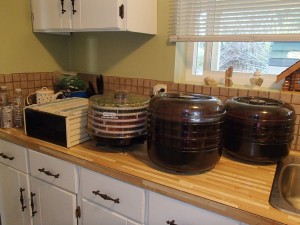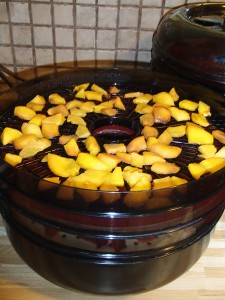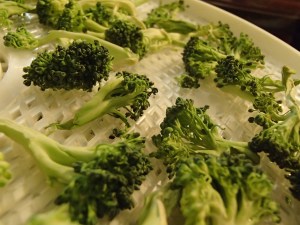
In these last two weeks before heading out, I have been dehydrating up a storm. On the downstairs counter is four dehydrators lined up in a row pumping out dehydrated food for us to take with us on our expedition. We try to have about one week of dehydrated meals as back-up in case we’re not able to forage for food (bad weather, surf beach, provincial and/or national park are just some of the reasons). However, in the DIY spirit, we dehydrate our own meals instead of buying camping freeze-dried meals…and it’s easy!
Dehydrating food makes it light, pack so much smaller and lasts a lot longer. Last week, I was dehydrating a lot of fruit (so tasty to munch on as a snack or to flavour porridge!) , fruit leather (ground up fruit and dried like a fruit roll-up from when you were a kid!), and veggies (broccoli, peppers and corn OH MY!). We also made our own beef jerky and it dehydrates so easy that you’ll never buy expensive store bought jerky again! This week, I am simply making dinner and dehydrating the left-overs. I currently have a big pot of chili simmering in a slow-cooker, which is a favorite back-up camping meal for us.
The secret’s out: YOU CAN DEHYDRATE (ALMOST) EVERYTHING!
A few simple rules:
- Fat does not dehydrate so try to minimize it. Yogurt can dehydrate but it never re-hydrates the same.
- Big chunks take longer to re-hydrate so chopping things really small or shredding is great, blending soups is even better! Chili using ground beef works well but I made another dish with chunks of chicken that took forever to re-hydrate.
- Dehydrate like with like. If you have one tray of peaches and another of broccoli, you’re going to get broccoli infused peaches (maybe ok?) and peaches that taste a bit like broccoli (not as good…)
- Mark the quantity you dehydrated so you know how much liquid to put back in. Add liquid conservatively….you can always add more water but you can’t take it out once it’s in!
That’s it! Have fun dehydrating! If you’re looking to get a dehydrator, the ones with fans in them are the best.
Here are some dehydrating tips and ideas our experiences:
Dehydrating Fruit

Fruit is amazing to dehydrate and it’s so tasty to munch on. It’s great in oatmeal and to supplement granola/trail mix. I chopped up apples, peaches, bananas and strawberries and also dehydrated some raspberries and blueberries too. With fruit, really anything is possible.
** With fruit that turns brown when left out (i.e. apples, pears, peaches), soak it in a little lemon juice and water for about 5-10 minutes before putting it on the dehydrator.
FRUIT LEATHER
A fantastic way of preserving fruit is to puree it and then spread it out on the dehydrating tray. Some dehydrators have fruit leather inserts but you can also easily make your own with parchment paper (not wax paper). You want to be careful to not over dry fruit leather or else it cracks. Once it is not sticky to touch anymore but still a bit pliable (like leather, who would have guessed?), peel it off carefully then cut into the size you want and roll it up in wax paper for storage.
Some of my favorite combinations are: raspberry & strawberry, blueberry & applesauce* with a 1/2 tsp of vanilla extract, and the all time favorite, blend up all the fruit I have in my fridge for a kickass mixed fruit leather!
*Apples are a great filler and give a little extra sweetness to sometimes tart berries. Applesauce is really easy to make. Just boil up four roughly cut and peeled apples with about 1/2 cup of water, add a little honey/brown sugar/ maple syrup as you like, optional cinnamon. Boil for about half an hour and then blend in a food processor or blender after it’s cooled a bit. Presto! Delicious homemade applesauce!
Dehydrating Veggies

Veggies also dehydrate well and it really reduces the weight and space of carrying delicious veggies. A large ziplock bag of broccoli turned into half of a small ziplock bag of broccoli. Six full sized carrots turned into something I could hold in the palm of one hand. Dehydrating veggies separate means you can be versatile with your meals, coming up with meals on the fly or jazzing up other meals. This is new for us and thanks for backpacking guru, Lauren, for her suggestion! Now, we will have our freshly caught fish plus a side of quinoa with some dehydrated veggies tossed in while its cooking for an awesome dinner!
Some tips dehydrating veggies:
- Soak broccoli in salt water for 10 minutes before throwing it on the dehydrator. This will help it keep its green colour
- Bell peppers (all peppers actually) dehydrate well and really keep their flavour. Chop it up in small squares for better dehydrating.
- Mushrooms soak up flavour so you can make little mushroom “bullion cubes” by soaking them in beef or veggie stock for about 10 minutes before dehydrating
- Frozen veggies work great. Throw frozen peas and corn straight onto the dehydrating trays
- Carrots can take a long time to re-hydrate. Some ideas for quicker re-hydration is to shred the carrots or cook them first. I tried cooking them this time and they dehydrated so small!
- Leafy greens dehydrate well including kale, Swiss chard, spinach and more. You can also dehydrate herbs quite well too
Dehydrating Meat
Meat can re-hydrate kind of tough and use a higher heat on your dehydrator to make it safe. Many dehydrators have a meat setting.
Ideas for dehydrating meat include:
- Deli cold cuts such as ham, turkey, chicken, lean roast beef – Cut into strips to dehydrate. This can be a great addition to mac and cheese!
- Canned tuna – Screw the heavy metal can! Make sure you get the tuna in water rather than oil
- Similarly, canned chicken! – the key apparently is that canned chicken is pressure cooked. If you have a pressure cooker, you can do it yourself. See this website for more details: http://www.backpackingchef.com/pressure-cooking-chicken.html
- Ground beef apparently dehydrates best with some breadcrumbs added in – 1/2 cup for every pound of beef, make sure you use lean beef. Bread crumbs allow more liquid to penetrate the dried meat when you re-hydrate it so it turns out more tender!
Honestly though, I don’t dehydrate meat separately all that much. I have ground beef in my delicious dehydrated chili but I don’t normally have a bag of simply dried ground beef. The BEST WAY to dehydrate meat is beef jerky!
BEEF JERKY
Beef jerky is so easy to make that you’ll never buy expensive store bought jerky again! First get a big hunk of beef roast then slice it. If you have a slicer, that’s great. If you don’t, a tip is to put the meat in the freezer for about 30 minutes before slicing and it will make it easier to cut. Cut the meat into about 1/2 inch slices – too thin will make the jerky really crispy while too fat will be hard to dehydrate. Use only lean meat for dehydrating and cut out fat parts as fat will go rancid and spoil faster.
We made a simple teriyaki sauce for the beef with soy sauce, brown sugar, lemon juice, a bit of garlic powder and cayenne. Some other things you can add in include liquid smoke, black pepper, onion powder, Worcestershire sauce, Frank’s hot sauce and Tabasco. Play with the different amounts and see what tastes good for you. Just make sure there is enough to cover all of the meat.
Leave the meat to soak in the sauce overnight and then put it on the dehydrator. Like fruit leather, you want the meat to be completely dry to touch but still pliable and bendy.
Enjoy and comment below on any dehydrating thoughts!!














Wow never thought of d.i.y dehydrated food! Does it suck the vitamins out of them or not really do you know? I might have to research and then try out your method! Looks great! Check out my all natural blog here if you fancy 🙂 http://jainisnaturalbubble.com/2015/06/15/why-i-have-been-washing-my-face-with-oil-and-not-used-any-creams-washes-or-soap-for-a-month/
LikeLike
Hey there Jaini! Thanks so much for reading my blog. As far as nutrient loss, apparently if you dehydrate on low temperatures, you don’t loose very much at all! Some people who eat a raw food diet use dehydrators because most things can be dehydrated under 118 degrees F and consequently, retain living enzymes! Meat, however, should be dehydrated at a higher temperature. Dehydration does not cause any change in fiber or iron content. I love your blog as well! Great smoothie ideas! 🙂
LikeLike
Jaini, I just read this info and thought of you!
“the dehydration process minimally affects the nutritional content of food. In fact, when using an in-home dehydration unit, 3%-5% of the nutritional content is lost compared to the canning method which losses 60%-80% of the nutritional content. Additionally, vitamins A and C, carbohydrates, fiber, potassium, magnesium, selenium and sodium are not altered or lost in the drying process.”
http://readynutrition.com/resources/dehydrate-foods-for-long-term-storage_31032010/
LikeLike
You are the queen of dehydrating. Nicely done.
LikeLike
Maggie, Jerry here from SOMF, thanks for the updates! I was just wondering if you could throw out a few more details like 1. How long do expect various foods to store dehydrated? 2. You mention putting food in zip lock bags, do use a vacuum packer for anything or does the zip locks work fine? Heading back down to SOMF over Labor Day for a little R&R and maybe start to update my blog all so. Keep the updates coming 🙂
LikeLike
Hey Jerry! It’s great to hear from you!
1. In our experience, veggies, herbs and fruit seem to last forever. When we were cycling from Vancouver to Argentina, we were carrying dried fruit, greens, tomatoes, carrots and peppers that had been dehydrated years before and it was fine. You just have to make sure that it stays dry. Meat, I think, is a different matter. Make sure you dehydrate it on higher temperature (one of our dehydrators had a meat setting at 145 degrees F versus 115 degrees F for fruit leather). Then, it lasts for about 2-3 months. I find it hard to keep homemade jerky around for that long anyways. You can also put dehydrated meat in the fridge to prolong their freshness.
2. I just use zip-lock bags. If you have a vacuum packer, I think everything will last even longer!
Thanks for your questions and let me know if you have any other 🙂 Looking forward to reading about your adventures so keep me posted on your blog! Many hugs!
LikeLike